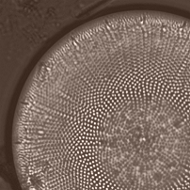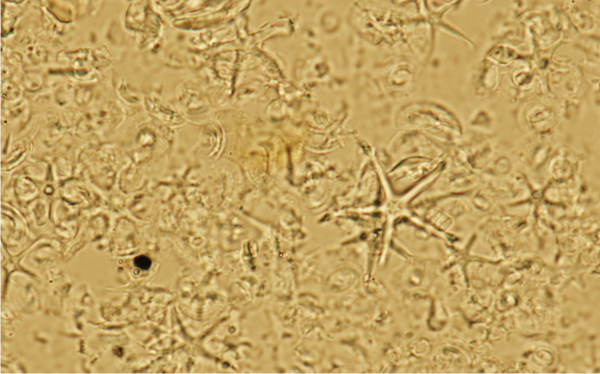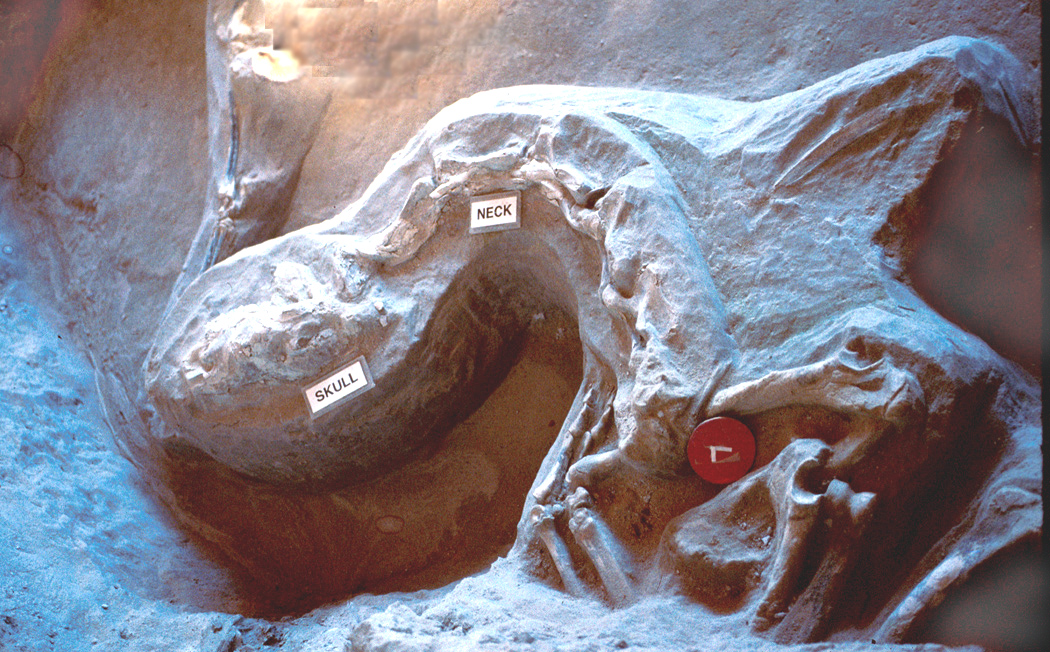Paleontology
Our department features research and graduate education in micropaleontology and vertebrate paleontology. We study some of the largest and some of the smallest creatures that were routinely fossilized during the Mesozoic and Cenozoic.
Our unique mix of specialties provides the means to examine ancient ecosystems from the heights of the mountains to the depths of the oceans, and from the equator to the poles.
Our students use these fossils to examine problems in taxonomy, biostratigraphy, evolution, paleoclimate, and paleoceanography. There is a large variety of paleontology courses taught on a regular basis, including courses on specific fossil groups. There are also many courses on topics related to paleontology. Students have access to the vast fossil and sample collections of the University of Nebraska State Museum and the UNL Ocean Drilling Program Micropaleontological Reference Center. Many of our students also find it handy to have a valid passport, since they may end up traveling to Antarctica, sailing on a research drilling vessel, participating in the Schramm field course, or doing field work in exotic places.
Micropaleontology

Diatoms in continental ecosystems - Sheri Fritz and her students use diatoms from lake deposits to examine questions of environmental change during the Quaternary. The Fritz Lab has on-going work on the paleoclimatic history of the Great Plains, Rocky Mountains, and tropical South America.

Diatoms in marine ecosystems - David Harwood and his students use diatoms from marine sediments to examine questions of evolution, biostratigraphy, and paleoclimatic change during the Late Cretaceous and Cenozoic. Much of the on-going work of the Harwood Lab centers around the diatomaceous sediments recovered from the coastal sediments of McMurdo Sound, Antarctica, by the ANDRILL Program.
Vertebrate Paleontology
Cenozoic mammals and isotopes - Ross Secord and his students use mammalian fossils and stable isotope geochemistry to examine how climate change drives faunal and environmental change. Stable isotopes in mammal teeth and contextual minerals provides information about the paleoclimate and paleoenvironment in which the mammals evolved. There are a number of times during the Cenozoic when faunal turnover or mammalian dispersal events appear to be correlated to climate change. The Secord Lab has on-going projects on climate and evolutionary events in the Paleogene of the Big Horn Basin.

UNL Fossil Collections

The Ocean Drilling Program Micropaleontological Reference Collection housed at UNL contains marine diatom and calcareous nannofossil samples from all of the world's ocean basins. The collection spans the upper Triassic through Holocene. The department also houses the H.V. Andersen Foraminiferal Reference Collection.

The University of Nebraska State Museum contains a collection of more than one million numbered specimens. The collection is dominated by Cenozoic mammals from the Great Plains, and also includes significant collections of Paleozoic fishes, Mesozoic marine reptiles, and Cenozoic lower vertebrates.
Graduate Courses
Paleontology
823. Quaternary Ecology and Climate (3 cr) Fritz
Analysis and interpretation of Quaternary paleoecological data. Patterns of long-term climate variation. Distribution patterns and responses of organisms and ecosystems to Quaternary environmental change.
830. Quantitative Methods in Paleontology (3 cr) Watkins
Numerical and statistical analysis of paleontological data including biometry, synecology and quantitative biostratigraphy.
831. Micropaleontology (3 cr) Harwood
Morphology, classification, ecology, and geological application of common fossil and extant marine, brackish, and freshwater microfossils.
835. Vertebrate Paleontology (3 cr) Hunt
Survey of the evolution of the vertebrates, including examination of the geological and biological factors that influence the pattern of evolution, and laboratory study of fossil materials of the major vertebrate groups.
836. Mammalian Paleontology (2 cr) Secord
Survey of Mesozoic and Cenozoic mammalian history, with emphasis on integration of geological and biological data on pattern and process in mammalian evolution.
935. Cenozoic Vertebrate Paleoecology (2 cr) Hunt
Terrestrial vertebrate history during the Cenozoic Era with emphasis on the fossil record of Great Plains mammalian communities within the last fifteen million years.
936. Siliceous Phytoplankton Paleontology (4 cr) Harwood
Biostratigraphy, paleoecology, and paleobiogeography of fossil diatoms, silicoflagellates and ebridians.
937. Mesozoic Calcareous Nannofossil Paleontology (4 cr) Watkins
Biostratigraphy, paleoecology, and paleobiogeography of Mesozoic calcareous nannofossils.
938. Cenozoic Calcareous Microfossil Paleontology (4 cr) Lec 3, lab 3.
Biostratigraphy, paleoecology, and paleobiogeography of Cenozoic calcareous nannofossils.
Related
814. Clay Mineralogy (4 cr) Holmes
Structures and properties of common clay minerals; their formation and geologic/pedologic distribution. Generation and use of x-rays for diffraction analysis. Analysis of clays and related minerals by x-ray diffraction and electron microscopy.
816. Isotope Geochemistry (3 cr) Kettler
Behavior of stable and radiogenic isotopes in geological and cosmochemical systems. Application of isotope geochemistry to determining the age of rocks, as well as the sources of the chemical components in the rocks.
817. Organic Geochemistry (3 cr) Kettler
Origin, preservation, and transport of the organic compounds found in the rock record. Applications of organic geochemistry to paleoclimatic and paleoenvironmental interpretations as well as to discerning the origins of coal, oil and natural gas.
821. Carbonate Petrology (3 cr) Frank
Depositional settings and processes, petrography, geochemistry, diagenesis and geological significance of modern and ancient carbonate rocks and sediments.
824. Biogeochemical Cycles (3 cr) Fritz
Chemical cycling at or near the earth’s surface. Interactions among the atmosphere, biosphere, geosphere, and hydrosphere. Modern processes, the geological record, and human impacts on elemental cycles.
828. Stratigraphic Architecture and Sequence Stratigraphy (3 cr) Fielding
Analysis of stratigraphic stacking patterns in sedimentary basins and sequence stratigraphic methods.
885. Fossil Fuel Geology and Exploration (3 cr) Fielding
Geology of coal, oil and gas, and methods of exploration for those resources.
895. Economic and Exploration Geology (2 cr, max 6). Recommended parallel: a GEOL course as indicated by the instructor and to vary with course content. Content will vary on a 3-year rotation. Combined lectures, seminars, weekend short courses, and field trips. Field trips are required and supported by alumni endowment. Field trips may be scheduled during semester breaks. E.F. Schramm Course in Economic Geology.
926. Marine Geology and Paleoceanography (3 cr) Frank, Watkins
Geology of the oceanic realm, formation of oceanic crust, circulation, geochemistry, pelagic sediments and their diagensis, correlation, and oceanic history.
929. Mesozoic and Cenozoic Stratigraphy (3 cr)
Application of stratigraphic principles and methods to the solution of Mesozoic and Cenozoic problems.